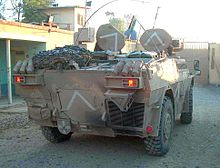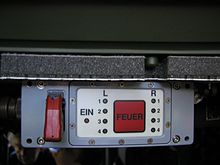Fennek scout car
| Fennek scout car | |
|---|---|

Fennek pre-production variant of the Netherlands |
|
| General properties | |
| crew | 3 (commander, driver, system operator) |
| length | 5.58 m |
| width | 2.55 m |
| height | 1.79 m top edge of the roof 2.18 m above the weapon station |
| Dimensions | 10.3 t (total weight) 10.7 t (combat weight) |
| Armor and armament | |
| Armor | STANAG 4569 Level 3 composite armor |
| Main armament |
Grenade machine gun 40 × 53 mm or 7.62 × 51 mm MG3 or 12.7 × 99 mm MG50-1 |
| Secondary armament | no |
| agility | |
| drive |
Deutz BF6M 2013C 177 kW (240 PS) |
| suspension | Torsion bar suspension |
| Top speed | 120 km / h forwards, 23 km / h backwards |
| Power / weight | 16.5 kW / t |
| Range | 1000 km of road, 460 km of terrain |


The Fennec (named after the eponymous desert fox ) is a lightweight 4-wheel - armored cars , since 2003 in the Bundeswehr (220 vehicles) and the Dutch army (410 vehicles) is used. The successor to the Luchs reconnaissance tank is the main weapon system of the army reconnaissance troops .
development
The first test vehicles were delivered in May 1997. The four vehicles were subjected to a technical test and a troop test. The first Fennek scout car was handed over to the troops on December 10, 2003 at the armored troop school in Munster . 178 vehicles went to the tank scouts, 24 to the pioneer troops as the successor to the Fuchs armored personnel carrier . Another 410 Fennecs went to the second cooperation partner of this bilateral joint project, the Netherlands.
In 2004, four of the vehicles ordered for the artillery troops were developed as observation vehicles and delivered to the troops as part of what is known as an “immediate mission-related requirement”. As the first of all Fennek variants, these four vehicles were used from autumn 2004 as part of the ISAF in Afghanistan. The artillery vehicles were only taken out of service in autumn 2005 after the actual reconnaissance vehicle's actual reconnaissance vehicle had been completed. The artillery developed two other variants of this vehicle for their Joint Fire Support Teams. In November 2007, the Dutch procurement authority Defensie Materieel Organizatie (DMO) on behalf of the Federal Office for Defense Technology and Procurement (BWB) ordered ten of these new Fennek vehicles for the Joint Fire Support Teams (JFST) of the Bundeswehr, which were delivered in 2010. Another order for another ten JFST vehicles followed. This increased the total number of vehicles of this type delivered to the Bundeswehr to 222.
The manufacturers of the Fennek are the systems company Krauss-Maffei Wegmann, based in Kassel and Munich , and the Dutch subsidiary Dutch Defense Vehicle Systems (DDVS).
Versions
- AD (General Service)
- Leadership and radio version
- Fü- / ErkdFzg Pi (command and reconnaissance vehicle pioneer troop)
- Pioneer exploration
- JFST (Joint Fire Support Team)
- Advance observer and flight control team (2 different equipment variants)
- LVB (Light Verkennings- en Bewakingsvoertuig)
- Reconnaissance and exploration version; the same version is used by the German Army Reconnaissance Force.
- MRAT (Medium Range Anti Tank)
- Anti-tank version
- SWP ( Stinger Weapon Platform)
- Anti-aircraft version
- TACP (Tactical Air Control Party)
- Emergency vehicle for Forward Air Controller as part of close air support
- VWRN (voorwaartse waarnemer)
- Artillery watchers
The Koninklijke Landmacht uses their 410 fennecs for different purposes. The following versions are in use, among others:
- 202 LVB
- 78 MRAT
- 18 SWP
- 6 TACP
- 16 VWRN
The German army uses the Fennek primarily for reconnaissance and reconnaissance. So far, the following versions are in use:
- 178 LVB
- 24 Fü- / ErkdFzg Pi
- 20 JFST
Reconnaissance and sensor equipment
In addition to the data processing system (DV system), the reconnaissance and sensor equipment consists of the following components:
BAA observation and reconnaissance equipment
One of the main technical features of the Fennek reconnaissance vehicle is the observation and reconnaissance sensors ( C⁴ISR ) manufactured by the Rheinmetall Defense Electronics company . This consists of the following three main components:
- the thermal imaging device Ophelios
- the eye-safe laser rangefinder Molem
- the visual black and white CCD camera.
The three sensors are installed together in a swiveling and rotating platform that is mounted on a mast that can be extended up to 1.5 m (total: 3.29 m) and comes from the GEROH company. This is a special spindle mast system with comparatively low deflection values, which is of crucial importance for the proper operation of the BAA. This head can also be operated in the detached state to optimize the observation area. Both the sensors and the platform are operated from the commander's or observer's seat via a control panel. The fields of view of the thermal imaging device and the CCD camera can be set identically using the snap-in positions of the daytime view zoom. Targets such as helicopters can be recognized up to a distance of about ten kilometers and identified up to about 2000 meters. The sensor platform can be rotated by remote control in vertical angle and azimuth . The display of the thermal image or the CCD camera is provided by an eye-friendly monitor that has been designed for long-term observations.
For observation independent of the vehicle, the entire platform can be mounted on a tripod and operated up to 40 m from the vehicle. This has the tactical advantage that the portable sensor system can also be set up at a window opening or at an obstacle in order to enable the observation of a section of the terrain. Furthermore, the independent start-up of the vehicle's sensors is advantageous in built-up areas where the Fennek cannot be positioned.
Ground sensor equipment location and identification (BoSA)
Stationary sensors such as the floor sensor equipment (BoSA) are used to monitor rooms and in hiding places in order to monitor prominent terrain points, important streets or culverts over a longer period of time.
The Bosa is intended to monitor vehicle movements on roads, paths and at points in the area of particular importance. It independently detects vehicles and reports their number, speed and direction of movement. It also identifies the common types of combat and combat support vehicles. It can transmit its reconnaissance results up to ten kilometers. One BoSA is carried per scouting party, distributed across both vehicles.
Aladin mini drone
In the meantime, Aladin , a small drone that is used by the patrol for close-up reconnaissance, is in action . The aircraft starts like a model airplane and has a range of around 5000 meters. Aladin flies and lands autonomously.
Armament
The vehicle can be equipped with a 40 mm grenade machine gun (HK GMW), a 7.62 × 51 caliber machine gun or a .50 caliber heavy machine gun . The Bundeswehr uses different armaments; On missions abroad, the vehicles are always equipped with at least one machine gun for self-protection.
Vehicle technology
Advantages of the all-wheel drive 4 × 4-Fennek are its low center of gravity at a height of only 1.79 m and a tire pressure control system . The combat weight is around 10.5 t. The maximum speed on the road is given as 120 km / h, but the speed is electronically limited to 92 km / h. A 5 t winch allows self-rescue.
The vehicle has a relatively low profile and long endurance on single missions. Due to these properties, this air-transportable and highly mobile vehicle should meet the requirements of today's range of tasks of the Bundeswehr. The armored car with three men needs one less crew member than the previous Luchs system .
Armor
The basic version of the Fennek is armored according to the standard STANAG 4569 Level 3 and resists fire with armor-piercing ammunition of caliber 7.62 × 51 mm at an impact speed of 930 m / s. According to the manufacturer, it is also possible to attach additional armor plates.
In many areas, the armor consists of embedded ceramic composite armor ( ceramic tiles on Dyneema fabric ), which has twice the protection level of steel armor with the same weight. The inner side of the vehicle with one of Dyneema or aramid fabric existing shatter protection ( Spall liners designed). This is to prevent armor material from splintering into the interior in the event of a penetration.
A serious stress test for the armor of the Fennek took place in an incident on June 28, 2006 in Afghanistan . According to the Bundeswehr, a patrol of the Bundeswehr's Provincial Reconstruction Team , consisting of a fennec and a dingo , was shot at around 0:15 a.m. south of Kunduz with RPG-7 bazookas, among other things . The driver and the commander got away with minor injuries.
Since armoring against shaped charge projectiles in this weight class and vehicle size is not possible in a purely passive manner, the low damage speaks for the protection concept. The Dyneema fabric attached to the inside of the Fennec reduced the splinters that would flake off in the event of a breakthrough to a minimum. This allowed the hazard area to be limited to the shaped charge jet. For vehicles of this size, heavy machine guns are more dangerous than shaped charge grenades as they can penetrate the vehicle, but have a much higher rate of fire than anti-tank weapons.
Technical specifications
| Unit price | 1.6 million euros |
| payload | 3000 kg |
| Tank capacity | 230 l |
| Engine torque | 819 Nm |
| Climbing ability | 60% |
| Max. Inclined position | 32% |
| Fording depth | 1000 mm |
| particularities | All-wheel drive, differential lock, tire pressure control system , rear view camera, 5 t cable winch, NBC protective ventilation system |
literature
- Reinhard Scholzen : Army reconnaissance. Motorbuch-Verlag, Stuttgart 2012, ISBN 978-3-613-03408-2 .
Web links
- Scout car (easy 4 wheel) Fennek - German Army
- Vehicle Fennek product information
- Private page about a pre-production model
- Fennek Wheeled Armed Reconnaissance Vehicle - army-technology.com
Individual evidence
- ^ Report of the Federal Ministry of Defense on the material readiness for use of the main weapon systems of the Bundeswehr. Federal Ministry of Defense, December 2016, accessed on 19 September 2017 .
- ↑ www.rheinmetall-defence.de Observation and reconnaissance equipment . Accessed May 5, 2014.
- ↑ Product specification | KMW. Retrieved March 22, 2020 .



